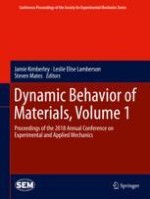2019 | OriginalPaper | Chapter
2. Ballistic Impact Experiments and Quantitative Assessments of Mesoscale Damage Modes in a Single-Layer Woven Composite
Authors : Christopher S. Meyer, Enock Bonyi, Bazle Z. Haque, Daniel J. O’Brien, Kadir Aslan, John W. Gillespie Jr
Published in: Dynamic Behavior of Materials, Volume 1
Publisher: Springer International Publishing
Activate our intelligent search to find suitable subject content or patents.
Select sections of text to find matching patents with Artificial Intelligence. powered by
Select sections of text to find additional relevant content using AI-assisted search. powered by
